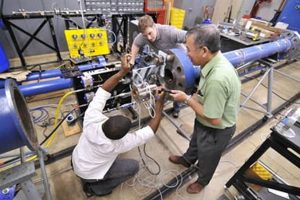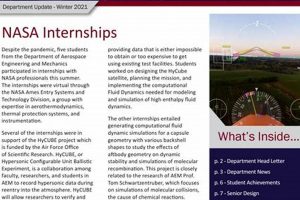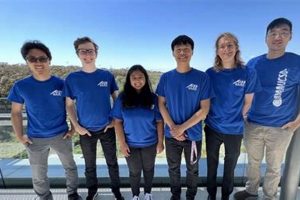The field encompasses the design, development, and testing of aircraft and spacecraft. It involves applying engineering principles to create systems that operate within Earth’s atmosphere and beyond. Professionals in this sector contribute to advancements in flight technology, propulsion systems, and vehicle structures, ensuring safety and efficiency.
Understanding the nuances within this field is crucial for individuals pursuing careers in aviation and space exploration. The work contributes significantly to technological progress, national security, and scientific discovery. Historically, the development of flight and space travel has driven innovation across various engineering disciplines, impacting industries far beyond the aerospace sector itself.
The distinctions in focus, specific skill sets, and typical job roles will be examined in the following sections. Consideration will be given to the educational paths and career trajectories associated with different specializations within the broader engineering discipline.
Professional Guidance for Aspiring Engineers
Selecting the appropriate specialization requires careful consideration of interests, aptitudes, and long-term career goals. The following guidance is designed to aid in the decision-making process for those entering the field.
Tip 1: Define Your Area of Interest: Ascertain whether your primary fascination lies within atmospheric flight or space exploration. An affinity for aircraft design and aerodynamics aligns more closely with aeronautical engineering, whereas a passion for spacecraft, satellites, and interplanetary travel points towards aerospace engineering.
Tip 2: Evaluate Required Skill Sets: Recognize the emphasis on specific skill sets. Aeronautical engineering relies heavily on understanding aerodynamics, propulsion within the atmosphere, and aircraft structures. Aerospace engineering, on the other hand, necessitates expertise in orbital mechanics, spacecraft design, and environmental control systems for space environments.
Tip 3: Research Potential Career Paths: Explore the available career paths within each discipline. Aeronautical engineers typically find employment in aircraft manufacturing, airline operations, and aviation regulatory agencies. Aerospace engineers often work in the space industry, government research facilities, and satellite communication companies.
Tip 4: Investigate Curriculum Differences: Scrutinize the curricula of relevant university programs. Compare the core courses offered and identify specializations available within each degree program. This will provide insight into the knowledge and skills emphasized in each field.
Tip 5: Seek Experiential Learning Opportunities: Pursue internships or research opportunities related to the chosen area of interest. Practical experience provides valuable exposure to real-world engineering challenges and helps refine career aspirations.
Tip 6: Network with Professionals: Engage with engineers working in both aeronautical and aerospace fields. Attend industry events, join professional organizations, and seek mentorship to gain insights into the daily realities of each profession.
The careful application of these tips can facilitate a well-informed decision regarding specialization. By aligning personal interests, skill sets, and career aspirations, aspiring engineers can maximize their potential for success.
The next section will delve deeper into the specific roles and responsibilities associated with each engineering specialization.
1. Atmospheric Flight Focus
The concentration on atmospheric flight represents a defining characteristic for one specialization within the broader engineering discipline of flight vehicle design and development. This specific emphasis distinguishes one career path from another, shaping the required skill sets and typical projects undertaken. Individuals working within this area dedicate their efforts to designing, building, and testing aircraft intended for operation within Earth’s atmosphere.
- Aerodynamics and Wing Design
The principles of aerodynamics are paramount. Engineers focus on optimizing wing shapes, airfoil designs, and control surfaces to maximize lift, minimize drag, and ensure stable flight. For example, designing the wing of a commercial airliner requires extensive wind tunnel testing and computational fluid dynamics simulations to ensure efficient fuel consumption and safe handling characteristics. This contrasts with the design of spacecraft wings, which may be used primarily for atmospheric entry rather than sustained flight.
- Propulsion Systems within the Atmosphere
Designing and integrating propulsion systems optimized for atmospheric conditions is crucial. This includes jet engines, turboprops, and piston engines, all of which rely on atmospheric air for combustion. Optimizing these systems for fuel efficiency, power output, and emissions reduction is a constant engineering challenge. For instance, developing a more efficient jet engine involves improving compressor and turbine blade designs, combustion chamber geometries, and nozzle configurations to extract maximum energy from the fuel while minimizing environmental impact. This differs from propulsion systems for spacecraft, which often rely on rockets that carry their own oxidizer.
- Aircraft Structures and Materials
Developing lightweight yet strong aircraft structures is essential for performance and safety. Engineers select and design with materials like aluminum alloys, composite materials, and titanium to minimize weight while withstanding the stresses of flight. An example is the use of carbon fiber reinforced polymers in modern aircraft fuselages and wings to reduce weight and improve fuel efficiency. This differs from the structural considerations for spacecraft, which must withstand the extreme temperatures and vacuum of space, as well as the intense forces of launch.
- Air Traffic Control and Navigation Systems
Designing and implementing air traffic control systems and navigation aids are crucial for safe and efficient air travel. This involves developing technologies for tracking aircraft, managing airspace, and guiding aircraft during takeoff, landing, and en route flight. Examples include the development of GPS-based navigation systems and automated air traffic control software to improve accuracy and reduce pilot workload. These systems are designed specifically for the atmospheric environment and are not directly applicable to spacecraft navigation in deep space.
The focus on atmospheric flight necessitates a deep understanding of aerodynamic principles, atmospheric propulsion, aircraft structures, and air traffic control systems. This distinct focus differentiates the skill sets and career paths of individuals who concentrate on atmospheric flight from those who specialize in the design and development of spacecraft and related technologies.
2. Spacecraft Design
Spacecraft design is a critical aspect of space exploration and satellite technology, directly aligning with the expertise of aerospace engineers. It involves the application of engineering principles to create vehicles capable of operating in the vacuum of space and enduring the stresses of launch and orbital conditions. This stands in contrast to the atmospheric focus typical within aeronautical engineering. Spacecraft design encompasses multiple facets, each demanding specialized knowledge and skills.
- Structural Integrity in Extreme Environments
Spacecraft must withstand extreme temperature variations, radiation exposure, and the mechanical stresses of launch. Design considerations involve selecting materials that maintain their integrity under these conditions and implementing structural designs that distribute stress effectively. An example is the use of multi-layered insulation (MLI) to protect spacecraft from temperature extremes. The design and implementation of these systems is distinct from aeronautical engineering which focuses on atmospheric pressure and aerodynamic forces.
- Propulsion Systems for Vacuum and Orbital Maneuvering
Propulsion systems for spacecraft must operate in the absence of an atmosphere and provide precise control for orbital adjustments. These systems often rely on chemical rockets, ion thrusters, or other advanced technologies. Engineers must consider factors such as specific impulse, thrust-to-weight ratio, and propellant storage. Designing a propulsion system for a satellite that needs to maintain a precise geostationary orbit requires knowledge of orbital mechanics and propulsion technology not typically encountered in aeronautical contexts.
- Power Generation and Management
Spacecraft require reliable power sources to operate their systems. Solar panels are a common choice, but other options include radioisotope thermoelectric generators (RTGs) for missions to distant planets where sunlight is limited. Effective power management systems are essential to distribute power efficiently and protect sensitive electronics. The design of a solar power system for a deep space probe necessitates careful consideration of solar irradiance, panel efficiency, and power storage requirements, factors that are less critical in aircraft design.
- Communication Systems for Long-Distance Transmission
Spacecraft must be equipped with communication systems capable of transmitting data over vast distances. These systems require high-gain antennas, powerful transmitters, and sophisticated signal processing techniques. The design of these systems must account for factors such as signal attenuation, Doppler shift, and interference. Establishing reliable communication with a spacecraft millions of kilometers away requires expertise in radio frequency engineering and signal processing beyond the scope of typical aeronautical communication systems.
These facets of spacecraft design highlight the unique challenges and engineering considerations that differentiate aerospace engineering from aeronautical engineering. The expertise required to design and build spacecraft, encompassing structural integrity, propulsion, power, and communication, represents a distinct specialization within the broader field, oriented towards the demands of operating beyond Earth’s atmosphere.
3. Aerodynamics Expertise
Aerodynamics expertise forms a cornerstone in the distinction between the two engineering disciplines. While both fields involve fluid dynamics, the application and emphasis differ significantly, influencing the educational focus and professional roles of each specialization.
- Airfoil Design and Optimization
The ability to design and optimize airfoils for specific flight conditions is paramount. This involves understanding the complex interplay of lift, drag, and stall characteristics to create efficient and stable aircraft wings. For example, computational fluid dynamics (CFD) simulations are used extensively to refine airfoil shapes for various aircraft types, ranging from high-speed fighter jets to fuel-efficient commercial airliners. This level of specialization is a core competency for aeronautical engineers, impacting fuel efficiency and aircraft performance directly. While some aerospace applications, such as designing re-entry vehicles, do involve aerodynamic considerations, the emphasis and specific challenges are markedly different.
- Boundary Layer Control
Managing the boundary layer, the thin layer of air adjacent to the aircraft surface, is crucial for minimizing drag and preventing flow separation. Techniques such as boundary layer suction or blowing are employed to maintain laminar flow and reduce turbulent drag. These methods contribute to improved fuel efficiency and enhanced aerodynamic performance, particularly at high speeds. Aeronautical engineers are primarily concerned with optimizing boundary layer control strategies for aircraft operating within Earth’s atmosphere. Aerospace engineers may encounter related concepts when designing atmospheric entry vehicles, but the environmental conditions and design goals differ significantly.
- Wind Tunnel Testing and Analysis
Wind tunnel testing provides crucial experimental data for validating aerodynamic designs and predicting aircraft performance. Analyzing wind tunnel results and correlating them with theoretical models is an essential skill. This involves understanding flow visualization techniques, pressure measurements, and force balance data. Aeronautical engineers frequently use wind tunnels to evaluate new airfoil designs, control surface configurations, and overall aircraft stability. While wind tunnel testing can be used for certain components of spacecraft, its primary application remains in the atmospheric flight domain.
- Computational Fluid Dynamics (CFD) Applications
CFD simulations are used to model airflow around aircraft and predict aerodynamic forces and moments. Expertise in CFD software, mesh generation, and turbulence modeling is increasingly important. This allows engineers to analyze complex flow phenomena and optimize designs before physical prototypes are built. Aeronautical engineers apply CFD extensively to analyze aircraft performance, predict stability characteristics, and optimize control surface effectiveness. While aerospace engineers may utilize CFD for tasks such as analyzing rocket exhaust plumes or simulating flow around spacecraft during atmospheric entry, the scope and specific methodologies often differ from those employed in aeronautical contexts.
The intricacies of aerodynamic expertise, as described above, underscores the distinct specialization within the broader engineering sphere. While both areas deal with the principles of fluid mechanics, the focus on atmospheric flight and the design considerations specific to aircraft create a clear distinction in the application of these principles, ultimately separating the professional domains and required skill sets.
4. Orbital Mechanics Knowledge
Orbital mechanics knowledge represents a crucial differentiator between aeronautical and aerospace engineering. While both fields rely on fundamental physics principles, the application of these principles to solve problems related to motion differs significantly. Aeronautical engineering focuses on movement within Earth’s atmosphere, governed primarily by aerodynamic forces and terrestrial gravity. Aerospace engineering, particularly in its astronautical branch, requires a thorough understanding of orbital mechanics, encompassing Kepler’s laws of planetary motion, orbital maneuvers, and spacecraft trajectory design. This knowledge dictates the feasibility and efficiency of space missions.
The practical significance of orbital mechanics becomes evident in mission planning for satellites, interplanetary probes, and crewed spacecraft. For example, designing a trajectory to Mars involves calculating precise launch windows, considering gravitational assists from other planets, and optimizing fuel consumption for course corrections. Similarly, placing a communication satellite into a geostationary orbit necessitates a deep understanding of orbital parameters and perturbation forces. Ignoring these factors can lead to mission failure or significant increases in cost and resource utilization. The principles are not typically relevant in aeronautical engineering except when considering high altitude aircraft whose mission profiles may require some calculation of orbital effects, or when considering very long range trajectory planning.
In summary, orbital mechanics knowledge is indispensable for aerospace engineers involved in spacecraft design, mission planning, and satellite operations. It provides the foundation for understanding and predicting the motion of objects in space, enabling the realization of complex space missions. The level of understanding and application of these concepts delineates a key distinction in the required expertise and professional focus, separating the atmospheric-centric focus of aeronautical engineering from the space-oriented domain of aerospace engineering. The challenges associated with these missions, such as accurate trajectory prediction and resource optimization, underscore the ongoing importance of this specialized knowledge.
5. Distinct Career Paths
Career paths diverge significantly based on specialization. The core focusatmospheric flight versus spacecreates separate professional trajectories. Individual skills and expertise directly influence available opportunities and the nature of engineering work performed.
- Aircraft Design and Manufacturing
Aeronautical engineers commonly pursue roles in aircraft design and manufacturing companies. These positions involve developing new aircraft models, improving existing designs, and ensuring compliance with safety regulations. Examples include Boeing, Airbus, and smaller aircraft manufacturers. Roles may include aerodynamics, structural design, or propulsion systems engineering. This path is less common for aerospace engineers, unless their expertise also encompasses atmospheric flight.
- Spacecraft Development and Satellite Technology
Aerospace engineers often find opportunities in spacecraft development and satellite technology. This involves designing, building, and testing satellites, probes, and other spacecraft. Companies such as SpaceX, Lockheed Martin Space, and government agencies like NASA are key employers. Roles can encompass areas like orbital mechanics, spacecraft systems engineering, or mission planning. Aeronautical engineers may contribute to aspects of atmospheric entry vehicles but will generally focus on conventional vehicles.
- Aviation Regulatory Agencies
Aeronautical engineers are frequently employed by aviation regulatory agencies such as the Federal Aviation Administration (FAA) or the European Aviation Safety Agency (EASA). These roles involve developing and enforcing safety standards for aircraft design, operation, and maintenance. Responsibilities may include aircraft certification, accident investigation, and air traffic control system oversight. Aerospace engineers may also find positions in regulatory roles, but their focus tends to be on the regulation of space launch activities and satellite operations.
- Research and Development
Both aeronautical and aerospace engineers contribute to research and development efforts in their respective fields. This may involve working at universities, government laboratories, or private research institutions. Research areas can range from developing new propulsion technologies to improving aircraft aerodynamics or designing advanced spacecraft materials. These positions often require advanced degrees and a strong background in theoretical engineering principles. The research will tend to be directly related to one of these specializations.
These distinct career paths underscore the practical implications of choosing between aeronautical and aerospace engineering. Individuals align their education and skill development with a specific focusaircraft or spacecraftultimately shaping the trajectory of their professional lives and engineering contributions.
Frequently Asked Questions
This section addresses common inquiries regarding the differences between the engineering specializations, providing clear and concise answers to inform prospective students and professionals.
Question 1: Is it possible to switch from aeronautical engineering to aerospace engineering (or vice-versa) after graduation?
While not impossible, transitioning after graduation requires additional coursework or on-the-job training to acquire the necessary specialized knowledge. The ease of transition depends on the specific roles and the overlap in skills. Some graduate programs may bridge the gap with targeted coursework.
Question 2: Which specialization offers greater job security and higher earning potential?
Job security and earning potential fluctuate depending on market demands within the aerospace and aviation industries. Both fields offer promising career prospects, but specific trends in space exploration, air travel, and defense spending can influence opportunities and salaries.
Question 3: Does a degree guarantee employment in the chosen specialization?
A degree provides a strong foundation, but employment is not guaranteed. Internships, research experience, and relevant skills significantly enhance employment prospects. Networking and demonstrating practical application of knowledge is advantageous.
Question 4: Are the fundamental engineering principles identical across both specializations?
Both rely on core engineering principles such as thermodynamics, fluid mechanics, and structural analysis. However, the application of these principles differs. Aerospace engineering incorporates orbital mechanics and spacecraft-specific considerations not typically emphasized in aeronautical engineering.
Question 5: What undergraduate courses provide a solid foundation for either specialization?
Mathematics (calculus, differential equations), physics (mechanics, electromagnetism), and introductory engineering courses (statics, dynamics, materials science) provide a robust foundation. Specific coursework in aerodynamics, propulsion, and control systems is also beneficial.
Question 6: Is advanced mathematics knowledge more important for aerospace engineering compared to aeronautical engineering?
Advanced mathematics is crucial for both, yet aerospace engineering often requires a more sophisticated understanding of orbital mechanics, celestial mechanics, and related mathematical models. Aeronautical engineering relies heavily on fluid dynamics equations and control theory. The specific mathematical emphasis varies based on the type of engineering.
The answers provided should assist in understanding the differences, and to provide guidance for those who are considering these areas of studies.
In conclusion, this information provides insight, and should make it easier to make informed decisions regarding area of studies and careers.
Aeronautical Engineer vs Aerospace Engineer
This exploration delineated key distinctions between the aeronautical and aerospace engineering fields. Core variations exist in their respective focus on atmospheric flight and space vehicle design, coupled with differentiated skill requirements in aerodynamics versus orbital mechanics. These distinctions directly influence career trajectories, leading to specializations in aircraft manufacturing, satellite technology, regulatory agencies, or advanced research. Specific paths need specific expertise.
Careful consideration of these distinctions is crucial for students and professionals seeking to maximize their impact within the broad engineering field. Informed decisions regarding specialization, coupled with targeted skill development, ensures valuable contribution to the progression of aeronautical and astronautical technology.







